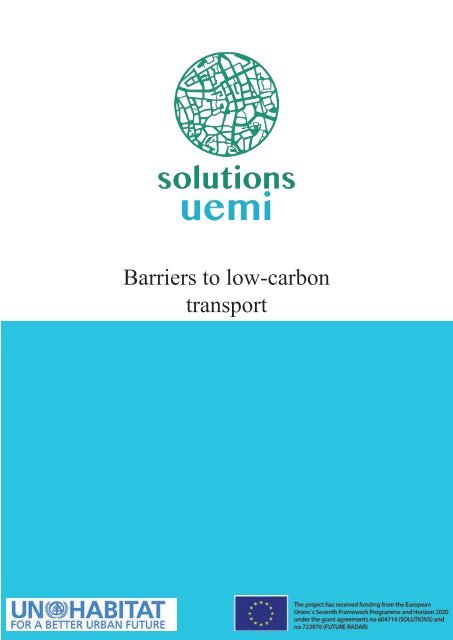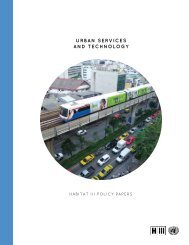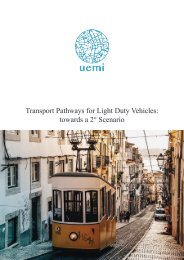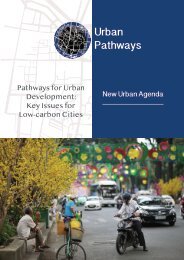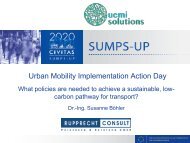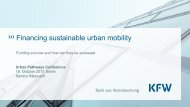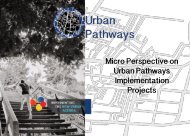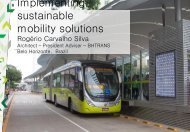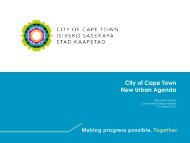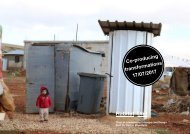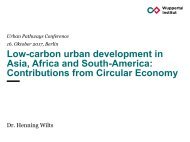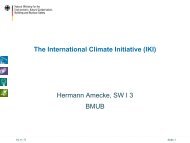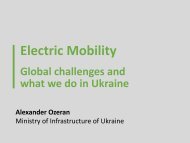UEMI_Barriers
Create successful ePaper yourself
Turn your PDF publications into a flip-book with our unique Google optimized e-Paper software.
<strong>Barriers</strong> to low-carbon<br />
transport
About this policy paper<br />
Shifting to a low-carbon development pathway requires<br />
substantial efforts for the transport sector.<br />
Electric mobility provides the opportunity to lower<br />
harmful emissions, improve energy security and increase<br />
economic productivity (Greene 2009). There<br />
is an immediate need to move towards low-carbon<br />
modes and energy carriers in the transport sector<br />
from an economic, societal and environmental perspective.<br />
Doing so harbours considerable potential<br />
for co-benefits if the technology is advanced enough<br />
to be introduced cost-effectively (Leinert et al. 2013;<br />
Viguié and Hallegatte 2012). Emobility technologies<br />
are, however, substantially underutilised; while some<br />
countries have made noticeable progress in this area,<br />
others have largely failed to do so (IEA 2015). There<br />
are split incentives between societal and individual<br />
benefits that create a collective action problem, which<br />
inhibits optimal outcomes in this area. This paper will<br />
explore those barriers and emphasise the need for policy<br />
intervention.<br />
Split incentives<br />
The initial-cost barrier is a major problem, in particular<br />
for individuals and despite available information<br />
on the relevant payback periods (Lescaroux 2010;<br />
Giblin, S., McNabola 2009). The key factor inhibiting<br />
the uptake of electric vehicles is the split incentive<br />
between individual- cost and economy-wide<br />
benefits, which is very strong in the transport sector.<br />
Vehicle purchases are made by individuals who apply<br />
discount rates as high as 20%, while most car buyers<br />
do not account for cost-savings from fuel efficiency<br />
beyond 2-3 years (ITF 2010). As such, only a fraction<br />
of the economy-wide benefits are considered by individuals<br />
when making purchase decisions, with negative<br />
consequences on the economy-wide benefits/<br />
costs over the roughly 15-year lifetime of the vehicle.<br />
The investment barrier is still the most prevalent<br />
obstacle to the widespread market penetration of<br />
energy efficient products (Sorell et al. 2009). A number<br />
of studies show that GHG reduction measures in<br />
transport have quite favourable abatement costs but<br />
require higher capital intensity than many measures<br />
in other sectors (McKinsey and Company 2009; Shalizi<br />
and Lecocq 2009). While these investments result<br />
in considerable economy-wide benefits over the<br />
lifetime of a vehicle, they may not create sufficient<br />
payback rates for the particular individuals responsible<br />
for vehicle purchasing decisions. Rebound effects<br />
may, however, undermine some of the efficiency<br />
gains, further complicating the collective action<br />
problem.<br />
Rebound effects<br />
The rebound effect refers to the tendency for total<br />
demand for energy decrease less than expected after<br />
energy efficiency improvements are introduced, due<br />
to the resultant decrease in the cost of energy services<br />
(Sorrell 2010; Gillingham et al. 2013). Ignoring<br />
or underestimating this effect whilst planning policies<br />
may lead to inaccurate forecasts and unrealistic<br />
expectations of the outcomes, which, in turn, lead to<br />
significant errors in the calculations of policies’ payback<br />
periods (WEC 2008). One of the most typical<br />
examples in the transport sector is improved vehicle<br />
efficiency failing to lead to the desired reduction in<br />
energy consumption, as efficiency gains are ‘taken<br />
back’ by increased travel. This effect is considerably<br />
less relevant from an electric vehicles perspective, at<br />
with. Provided that the energy is produced from renewable<br />
sources increased travel would not necessarily<br />
erode the efficiency gains made by the technology<br />
shift. Congestion and land-use factors may, however,<br />
be affected.<br />
The collective action problem<br />
Vehicles perchance decisions are made by individuals<br />
and personal motivation and societal objectives are<br />
not always aligned (Olson 1965). Individuals tend to<br />
be driven by rational behaviour and therefore favour<br />
the most cost effective choice, even though it may be<br />
morally objectionable (Diamond 2005). In the case<br />
of global climate change, individual perpetrators can<br />
be relatively certain of getting away with bad behaviour<br />
(e.g. driving a large instead of a small car) if<br />
there is no policy framework influencing individual<br />
behaviour. This represents the typical social dilemma<br />
situation, which discourages individuals from cooperating,<br />
as they can free-ride on the contributions of<br />
others. Atmospheric pollution is a reverse tragedyof-the-<br />
commons. It is not the situation of removing<br />
something from the commons but putting something<br />
into it (the atmosphere), namely carbon dioxide. The<br />
overuse of the atmosphere as dumping ground for<br />
greenhouse gases is the result of individuals making<br />
the rational decision to maximise their gain (wealth,<br />
comfort, status etc.) by increasing their carbon footprint<br />
or at least by not to reducing it (Stern 2006).<br />
This encourages bad behaviour, as good behaviour<br />
would be punished (e.g. higher travel time by taking<br />
the bus, or higher prices through flight emissions offsetting).<br />
Energy consumers are generally rational,<br />
however each individual acts differently. Governing<br />
the commons means also coping with the different<br />
habits of its users (Dietz 2003, Stern et al. 2002).


